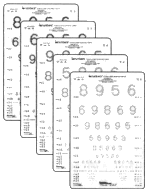Contrast Sensitivity Tests

Contrast sensitivity measurement is an effective way of detecting changes in visual pathways in persons who experience some change in their vision but have no change in visual acuity values measured at high contrast (Järvinen and Hyvärinen 1997). Several common eye diseases, like diabetic retinopathy, cataract and glaucoma often cause slow decrease in contrast sensitivity and thus affect quality of vision.
In occupational health contrast sensitivity is easiest to measure with low contrast visual acuity charts. Since they are used on the same lightbox as the high contrast visual acuity charts, luminance level is the same throughout the examination. The most commonly used chart is the 2.5% chart. It is low enough a contrast to give a measure point far from visual acuity at full contrast, yet it is easily seen by all normally sighted and most workers with some changes in their eyes or visual pathways.
Normal values at 2.5% contrast have a range between 0.3 - 0.8 (20/60 - 20/25; 6/18 - 6/9). Since the range of normal values is so large, it is advisable to measure contrast sensitivity as a part of health examination of all young workers and use that contrast sensitivity as the normal value in subsequent examinations of that person.
High contrast sensitivity is of value in tasks where the work contains important low
contrast details. Typical tasks are:
- driving in winter if the road is snow covered, and driving in fog or rain;
- visual inspection in industry is a visual task that depends on good vision at low contrast levels. Other tasks where good vision at low contrast levels is important is for example finishing the surface of white boats;
- visual surveillance in aviation where planes need to be detected in low clouds;
- diagnostic work in medicine especially in radiographic department but also in dermatology and ophthalmology;
- artists and craftsmen often have the same visual inspection tasks as inspectors in industry.
A Net Version of The Above Low Contrast TestPersons who want to follow-up possible changes in contrast sensitivity, can do it whith this picture. You need to use the same computer and do not change the luminance or resolution of the screen.
|
Vision in Occupational Health I Instructions for LEA Test System I Vision tests I Main page